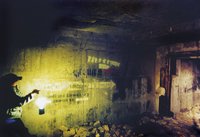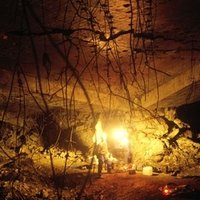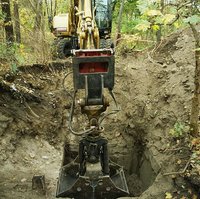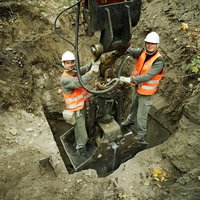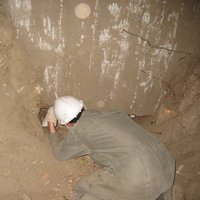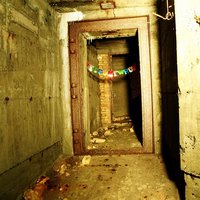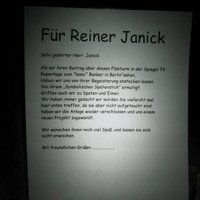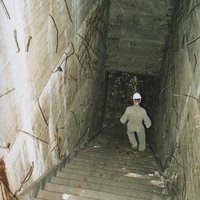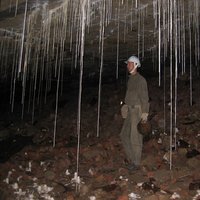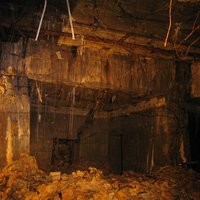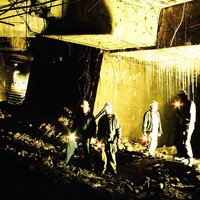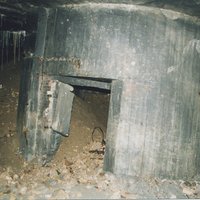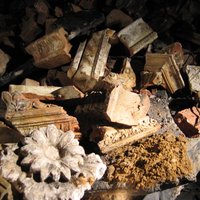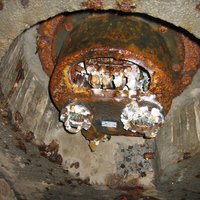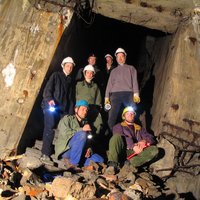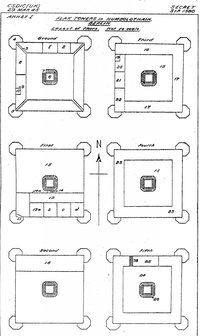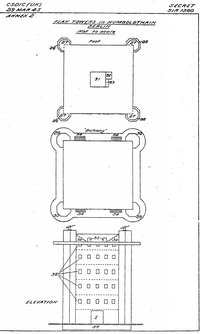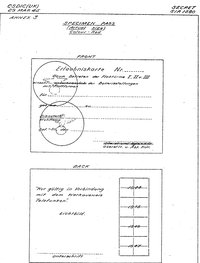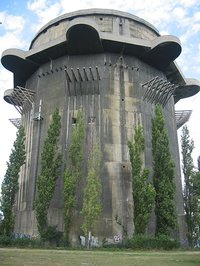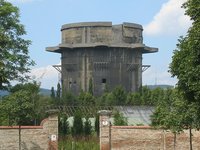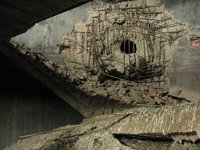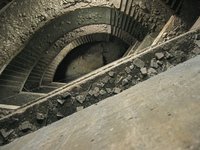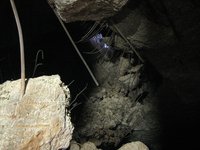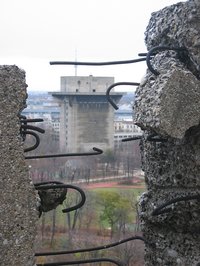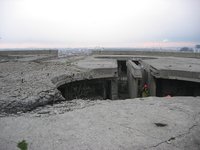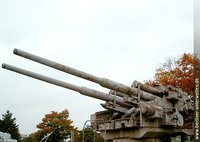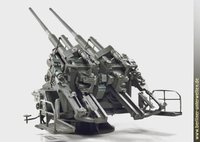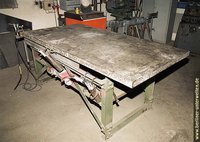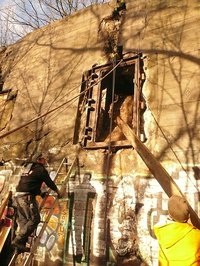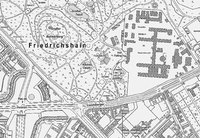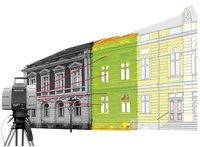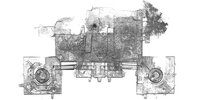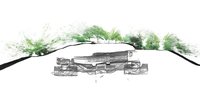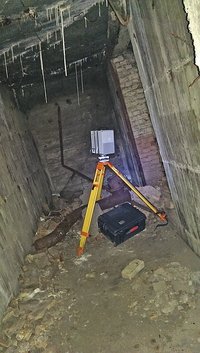Humboldthain Flak Tower – Project
1997 – Expedition to "Mont Klamott"
Entering the ruins of the Humboldthain flak tower 1997/98
On a cold November evening, we succeed in breaking through. For five nights we dug secretly, feeling more like the escape tunnel diggers of the 60s than passionate underground explorers. Our group had the irresistible goal of returning once again to that mysterious and forbidden world where we had spent part of our youth, to a place in the middle of the big city that was very close and yet inaccessible, a place others didn’t even know still existed. We had prepared everything for months. Historical plans and photographs had been analysed; numerous contemporary witnesses had been interviewed.
In the process, we had come across a suitable spot for our entrance. A photo from the immediate post-war period showed a long crack in the concrete wall of the bunker, more than two metres thick, caused by blasting by French engineers, which had later been filled with rubble. Here we wanted to make our way into the interior of the partially destroyed colossus. A weekend during a period of bad weather seemed to be the appropriate time for the adventure. It’s drizzling and the temperatures are only slightly above freezing. Who would want to go for a walk in the bunker park in this?
On Friday at 10.30 p.m., our expedition team sets off. Three members are assigned to dig, three others are responsible for removing the overburden. The rest form the security team. If a dog owner or a pair of lovers come along, the alarm is sounded and the work is interrupted. Only after midnight does it become noticeably quieter and we finally make progress with the digging. By the time dawn breaks, the first three and a half metres are done. We secure and camouflage the entry point and arrange to meet again the next evening.
The work progresses well on the second and third nights, because the dense root system that has developed here over the last four decades makes the subsoil quite stable, so that only a quarter of the initially calculated supports are needed. But on the fourth night, everything almost falls apart. The security team once again reports “visitors”. Our equipment quickly disappears into the undergrowth and under a pile of leaves. The overburden brigade mimics a merry drinking party that has gathered here to drink. But the walker’s dog races towards the entrance hole and starts barking loudly. He has scented the digging party in the tunnel. But the three down there remain calm. The man looks briefly at the inconspicuous-looking hole in the ground and finally tugs his dog on. Everyone breathes a sigh of relief.
Shortly before dawn, it’s finally done. The underground team emerges from the now 10-metre-long tunnel with the joyful news: “We’re through!” At this point, however, it’s not possible to go in because the necessary equipment has to be brought in first. So, we cover the entrance again and arrange to start the long-awaited expedition the next night.
But the onset of winter renders all our plans moot. In the dense white blanket of snow, our tracks would immediately stand out. Only weeks later, when the thaw sets in, can we finally venture out. Divided into three inconspicuous small groups, we climb the bunker mountain one evening, heavily laden. Water canisters, bags of food, ropes, photo equipment, insulating mats, and even my little accordion are with us. Seven of us descend at intervals. One team stays outside to keep watch and to close the entrance behind us again so that no one can suspect anything during the day. They are also responsible for uncovering the entrance when we want to get out again.
First, we have to crawl through the long, narrow tunnel lying on our stomachs. I push my camera bag in front of me and pull my backpack along. Only a small helmet lamp provides light. After a good stretch, I come up against a concrete wall, the passage bends to the right. Our calculations were probably not quite perfect. But only a little further on, the gap in the concrete that I had originally aimed for, about a metre wide, opens up. The goal is reached. We enter the interior of the bunker, where everyone gathers. Long, thin, white stalactites hang from the ceiling. Wildly tangled steel reinforcements can be seen in the lamplight, some of which have large chunks of concrete hanging from them. Rubble lies everywhere. It looks like a damp, grey cave.
Slowly, the memories come flooding back. The last time I was down here was probably when I was fifteen years old at the end of the 1970s, about the same age as many of the flak helpers at the end of the war. Reiner tells me that he managed to enter the buried facility even before I did. But today everything seems different. Only with difficulty can we work our way up to the preserved north-west tower of the bunker ruins. Once there, we discover that the once wide concrete spiral staircase has largely been torn from its anchors by the blasting. Only a few fragments of concrete are still hanging loosely on the walls. There is a steep drop of about twenty metres. Our group of seven decides to abseil down in stages.
Once on the next floor, another surprise awaits us. In the tower rooms facing outwards, dozens if not hundreds of bats hang from the ceilings and walls. Apparently, we have woken them up because they scream bloody murder without leaving their spots. It’s hard to believe that bats can get so loud. We quickly withdraw from this area, which could certainly become a rich research site for the Berlin bat experts.
After two hours, everyone finally arrives on the ground floor, where we set up our base camp for further exploration. Insulation mats are rolled out, equipment is unpacked, batteries are changed, and Gudrun makes strong coffee, much to everyone’s delight. We divide into three groups to explore the artificial labyrinth in different directions. After about three hours, we meet again at the starting point and exchange our first impressions. Robert, who has inspected the upper floors with Olaf and Solon, brings back an old Schultheiß beer bottle. On the porcelain cap it says: “Property of the Luftwaffe”. Reiner and Gudrun have documented the interior on several films, but it turns out that our battery light is too weak for the surprisingly spacious halls. Jürgen and I advanced to the former east entrance, through which thousands of people once streamed in when the siren alarm sounded. There we also find old wall inscriptions with directions to room 55, where the “information and briefing” sessions were once located. However, the room itself no longer exists. The blasts in 1947 and 1948 literally pulverised all the interior walls that were not made of reinforced concrete.
After the end of our meeting, we look at the clock to see that another day is already beginning outside, but down here time seems to stand still and we are only at the beginning of our explorations. In the next round, Jürgen, Olaf and Solon go in search of a cable duct which, according to eyewitness accounts, should lead over to the control tower, where the radio measuring devices were stationed for homing in on attacking bomber formations. On a level below the ground floor, they actually find the entrance to a “crawl space” through which all the important cables once ran. At the end of it, they even come across casings of old radios and fragments of an “Enigma”, a coding device for encrypting messages, but they don’t find the transition to the cable channel anywhere. Meanwhile, along with Robert, I begin a rough survey of the entire system. We make rapid progress with the laser measuring device. In the process, we also penetrate areas where no one has likely been for 50 years. Climbing through cracks between broken concrete slabs, we also reach the former west entrance of the bunker. Here lie the two six-centimetre-thick steel gates in front of which many people stood in despair during the air raids, after arriving too late and not being let in.
At the next briefing, Reiner and Gudrun report on the remains of the old ammunition hoists they found. They show rusted metal links like from an oversized bicycle chain. They belong to the former lift system that was used to transport the shells from the ammunition chambers on the ground floor to the roof of the flak tower, where the anti-aircraft guns were positioned. They also encountered the remains of the lift with huge gears among concrete fragments. At the end of this evaluation round, we notice that the first of us are beginning to show signs of overtiredness. No wonder - after all, we’ve been down here for 28 hours without sleep. But now that we want to take a break, we realise that we’ve misjudged the temperatures. Although there are enough insulating mats, at only ten degrees it’s hardly possible to sleep without blankets. We only have two sleeping bags. We try a kind of rotation system. After a few hours for everyone, we decide deep in the dark to start the new day. Gudrun and Reiner prepare an improvised breakfast, I then rouse the “sleeping bags” with loud accordion noises. After the first rough orientations, the detailed investigations now follow.
The ground floor area has proved to be particularly interesting, where, in addition to the walled northern main access, there are also the ammunition chambers lying somewhat deeper. Today, two underground lakes with clear, turquoise-blue water have formed over the decades. The remains of the enormous hinges for the ammunition depots’ closing flaps are also impressive. In some places we also discover modern graffiti, but we can’t find any traces of a neo-Nazi cult site, which, according to newspaper reports, existed here in the 1980s.
On our way through the floors, we try once again to understand the effects of the bunker blasts of 1947/48. Of the bunker towers to the south, nothing is left except for an area on the ground floor. Here everything has collapsed like a house of cards. In contrast, the northern half of the bunker near the S-Bahn tracks is still surprisingly well preserved over all six floors. The four main pillars in the centre of the bunker have apparently been deliberately blown apart, so that the intermediate ceilings all sag and form bizarrely interlaced inclined planes. The approximately three-metre-thick ceiling leans at an angle of almost 45 degrees against the intact half of the bunker and - like a sarcophagus - solidly covers the underground labyrinth. On top of it are thousands of tons of rubble.
In the evening, our expedition inevitably comes to an end because the water supplies have run out. We drag the equipment towards the ascent point and climb back up with difficulty. We call the outside team by radio, and they promptly uncover the entrance again. One by one we return, exhausted, to the outside world. Afterwards, the tunnel is thoroughly filled in, because no inexperienced person should be able to repeat our adventures at this point. The danger would be too great.
We’ve been busy for some time with the evaluation of our exploration material. Since there are no more historical plans of the site, we can now make a first outline. It turns out that the basic internal structure is different from what some contemporary witnesses remember. We have also noticed deviations from the allegedly identical towers at Zoo, in Friedrichshain, and the still intact flak tower on Hamburg’s Heiliggeistfeld. We’re glad to have taken a big step forward with our findings on the history of these bunkers. They’ll be useful to us because we intend to come back.
Excerpt from the book “Sirenen und gepackte Koffer – Bunkeralltag in Berlin” (Sirens and Packed Suitcases - Everyday Bunker Life in Berlin)
2004 – Success in Friedrichshain
Entering the ruins of the Friedrichshain flak tower
Note: The following text is taken from the association’s report on entering the ruins of the Friedrichshain flak tower in November 2004 and is therefore not strictly scientific.
The association had long been fascinated by a mountain in Berlin - “Mont Klamott” in Volkspark Friedrichshain. As early as 2001, some members of the AG Bunker & Luftschutzanlagen (Bunker & Air-Raid Shelters Association) were thinking about how to get inside the second Berlin flak tower, or rather its ruins. However, due to the activities that developed in and around the ruins of the flak tower in Humboldthain, this idea had to be put on the back burner for the time being.
In autumn 2004, a unique opportunity presented itself. In connection with a planned documentary about the association by the director Peter Prestel from ZDF, who was in charge of the series “Abenteuer Wissen” (Adventure Knowledge), the idea developed to venture entering the flak tower in Friedrichshain. The preparations for this started as early as September. First of all, official permission had to be obtained from the responsible district office in Friedrichshain-Kreuzberg. Once this was in place, those involved could start with the actual preparations. After several rounds of talks, we decided to start at the north-west tower, which is in the direction of the Märchenbrunnen.
Preparation and start of the excavation
Several historical photographs helped us choose a possible entry point. At first, we favoured an excavation attempt at an entrance to tower III from the lower platform, similar to our entrance to the Humboldthain flak tower. However, we would have had to dig an approximately six-metre-deep shaft by hand and brace it with timber to secure it. An attempt to enter via the former fifth storey, which would have required a not so deep excavation, was also rejected.
Based on our knowledge of the layout of Humboldthain and our examination of the photographs, we assumed that the former central staircase was so completely filled with rubble that it would not be possible to get through to the lower floors. Finally, we decided to try it via the ammunition lift shaft. This idea was welcomed by all participants, because we had gained enough experience with the cleared lift shaft in the Humboldthain flak tower.
In addition, we could save a lot of timber for the necessary bracing because, this way, we would have four safe side walls made of reinforced concrete. No sooner said than done - on Monday, November 1st, 2004, the time had come. Our in-house mechanic had thankfully agreed to drive the excavator, which was delivered punctually at 9.30 a.m. The excavation site had already been surveyed the previous week, so that the ammunition lift enclosure could be reached after barely two hours of excavation work. The site logistics and set-up were coordinated from the office.
It was unbelievable how quickly the excavation work progressed with the help of heavy machinery. Some of the group talked shop about how long it would have taken manually with shovels and spades. Several weeks would probably have passed but, with the excavator, the goal could be reached on the first day as dusk was setting in. Now, the first of the excavation team could risk taking a look inside the flak tower.
In the almost five-metre-deep pit, he crawled under the ceiling he had reached into the interior and came out again after a few minutes, completely thrilled. A little later, another association member brought the first photographic impressions up with him. In one picture, a kind of garland could be seen which, at first glance, looked like letters cut out of tin cans. You could read the words “Welcome home” - a legacy of the rubble workers? We decided to secure the excavation pit at around 8 p.m. and looked forward to the next day.
Two years too late…
After the barriers were removed on Tuesday, the first two association members (Reiner Janick and Charlie Noack) entered the facility together. After a few minutes, however, we were bitterly disappointed - we were not the first! This is how the Briton Robert Scott must have felt when he and his team reached the South Pole a few weeks after Roald Amundsen on January 17th, 1912, and found the Norwegian flag. Instead of a flag, our excavation team found a letter of welcome, addressed to Reiner Janick, with the following content:
“Dear Mr Janick, when we saw your contribution on this flak tower in the Spiegel TV report on the subject of ‘Bunkers in Berlin’, we were infected by your enthusiasm. Encouraged by your symbolic ground-breaking ceremony, we too took up bucket and spade. We always thought we might meet you down here one day. But, since you didn’t show up, we closed the site again and turned our attention to a new project. We still wish you a lot of fun and don’t get caught. Yours sincerely...”
From a second document, laminated to protect against moisture, we were also able to find out when the unknown excavation group had managed to get into the ruins of the Friedrichshain flak tower:
“We started the construction of the tunnel on a rainy night on 23.07.02. On 27.10.02, we reached the fifth floor for the first time. The passage to the fourth floor was made between 2.12.02 and 25.1.03.”
We had arrived a whole two years too late! All those present in our excavation group took their hats off to this achievement. Especially noteworthy was the fact that the unknown people had dug a passage from the fifth to the fourth floor, for which a small opening in the ceiling that had disappeared under about two to three metres of rubble had to be found and uncovered. Even more astonishing to us was the fact that absolutely nothing was known about the tunnel diggers’ project, not on the internet or through any other sources.
A really clean, sporting and commendable job, as we discovered together. Maybe the unknown diggers will get in touch with us some time to share their experiences? That would certainly make our day. After we had overcome this shock and our slight disappointment, we also went into the depths of the mountain. As we soon discovered, the site had not been officially entered since it was filled in, apart from our strangers, of course.
Remarkable dimensions opened up. The ceilings of the floors that were easier to walk on were all in better condition than the sagging intermediate ceilings in the Humboldthain flak tower ruin. The stalactite formations were also impressive. Stalactites and stalagmites that had grown together over a distance of up to six metres could even be discovered. The blasting had caused the bunker to tilt. All of the expedition members had a lot of trouble with orientation when they had to walk through sloping corridors and staircases with the stalactites hanging straight from the ceiling. This really upset their sense of balance.
...nevertheless a complete success
The deeper it went, the more the floors were affected by the blast. At the bottom, even the bunker experts found it difficult to determine whether they were parts of the former ground, first, or second floor. As one of the surprises, we discover the 12cm-thick steel gates still at the former main entrance of the facility, which had not been recovered by scrap dealers.
Now, we all realised that the doors of the large bunkers had been closed before the blast to contain the explosion pressure. One of the research routes then led some of us over to the demolished tower II, which could only be reached via a long and complicated crawlspace but is probably one of my most beautiful and impressive experiences in Friedrichshain. We even discovered old military toys and together were able to salvage two bolts from a steel door, which we will show to our visitors in the Humboldthain flak tower. The television crew accompanying us also got their money’s worth. The recordings were to flicker across the screen in March 2005. So, we were all once again able to look forward with anticipation and, when the time finally came, we were not at all disappointed.
On Wednesday, a distinguished visitor arrived. Professor Winfried Mengin, Director of the Berlin Museum for Pre- and Early History, visited our construction site, gave an interview to the ZDF film crew, and was not sparing in his praise for our association. His fine threads, however, did not allow him to enter the tower. He had come to us directly from a reception hosted by the Queen. The head of the responsible parks department was also more than impressed by the dimensions. Even he didn’t know what huge hollows were still under his Volkspark. But the good thing about this meeting was that I was able to elicit a promise from him that we could enter the flak tower again. Now that we know and can assess the dangers and risks, we want to give other interested association members the opportunity to enter the mountain.
We would like to take this opportunity to thank the district office of Friedrichshain-Kreuzberg for their support and permission for this expedition and look forward to seeing Friedrichshain again - and maybe we will even meet the unknown tunnel diggers!
Author: Dietmar Arnold, April 28th, 2015
2004 – Documents discovered in the Washington National Archives
on the Humboldthain Flak Tower and the TELEFUNKEN company
The Washington National Archives, as not many people know, are spread all over the United States. Every state, even Hawaii and Alaska, has its own branch. In the Washington D.C. metropolitan area, the archive has two locations, one in the city centre, directly on Pennsylvania Avenue, and a spacious new building inaugurated in 1994 in the small town of College Park in Maryland. House 1 is primarily concerned with older documents, from the time of American independence to around 1900, as well as genealogical research, while House 2 (College Park) mainly serves contemporary history.
The present document comes from House 2, namely from the holdings of the U.S. War Department. The exact archive signature is: RG (=Record Group) 165, Entry 179, Box 664, SIR 1580.
Preliminary remarks:
This document was found and translated by Ingmar Arnold in spring 2004. Translator’s notes are marked “[I.A.]”. The footnotes not only serve to orientate and inform the reader, but above all to give an idea of the role that terminology - its precise application or also an adequate translation into one’s own language - plays in understanding the respective other, but it is also the enemy. In a sense, one can even speak of a kind of “back translation”. Thus, to a certain extent, the transcripts of Private Langer’s interrogations, which are unfortunately not included in this document, and which were certainly conducted in German, become visible again. And it is astonishing how often the Allies fall back on German terminology.
The document definitely shows some errors as well as discrepancies with the knowledge we have today about the use of individual floors and areas, which could be gathered conclusively from other documents and eyewitness accounts. We do not wish to point these out or comment on them in detail here, but rather let the present document stand on its own merits. The reasons for incorrect information can be manifold, for example:
1. The interrogated person did not have the correct information.
2. The interrogator had the correct information but misrepresented it from his memory.
3. The interrogator recorded the information received incorrectly.
4. Errors in transmission or translation.
The document
CSDIC (UK)1 – SIR 15802 – March 29th ‘453
-THIS REPORT IS CLASSIFIED.-
Report on further information obtained from the testimony of KG CS/1621, Private Langer of the Wehrmacht Intelligence Command Regiment 3014, who was captured in Godesberg on March 6th, 1945.
THE FLAK TOWERS IN HUMBOLDTHAIN, BERLIN
(GSGS 4480 City Map of Berlin, Sheet 1, D 12, approximately at 4020, south of the railway line).5
This report should be read in conjunction with SIR1175.6
INTRODUCTION
1) KG7 is a young technician who worked for Telefunken before and during the war. He is an anti-Nazi, left his job in September ‘44, and lived in hiding in Godesberg for six months to await the arrival of the Allied armies. KG is cooperative and his statements, although limited in scope, can be considered reliable.
2) Before the war, KG was employed at the Telefunken branch in Cologne. In March 1944, he returned to his company on indefinite leave as a civilian armaments worker from the Wehrmacht until he was ordered to work for an experimental department [of the Telefunken company, I.A.] that had been set up in the flak tower in Humboldthain. KG was also in a room on the fifth floor used by [the company] SIEMENS. (See Annex 1, item 25.)
THE FLAK TOWER
GENERAL DESCRIPTION
3) There were two towers that were built close together. In the tower where KG worked, there were anti-aircraft guns, while on the other one, a “Würzburg device”8 was mounted. Both towers were also used as shelters for the civilian population.
THE CONSTRUCTION OF THE TOWERS
4) The tower itself was square, 50m wide and 45m high. The other tower was equipped with DF equipment9 and was about 10m smaller. There are no further details about this “Würzburg tower”.
5) At each of the four corners of the turret, an additional octagonal tank turret was added, which reached to the top of the structure. The roofs of these towers then formed the platforms for the guns. Including the roof, the gun tower had a total of six storeys. In addition, there was a 6-metre-wide “balcony”, which stretched all the way around the fifth and sixth floors. This was used for the two-centimetre guns. (See Annex 2.)
6) The concrete thicknesses of the turret were as follows: roof: 4.50 metres, walls: 3.50 metres, each floor: 1 metre.
7) Two lifts were installed in this tower. They reached up to the fifth floor and were used by both KG and civilian personnel.
8) Each floor had five windows on the north and south sides, but no windows facing east or west. During air alarms, the windows were sealed with steel screens.
FLOOR PLAN
9) For the tower floor plan, oriented according to the floors, see Annex 1 and Annex 2.
THE TELEFUNKEN SERVICE ROOMS
ASSIGNMENT
10) Telefunken started the experimental department in the flak tower after the main production plant [of this company, I.A.] in Berlin-Zehlendorf had been bombed out. KG does not know when this department was set up exactly, probably a short time before he was transferred there (March ‘44).
11) The experimental department occupied half [of the area] of each of two floors, more precisely, the first and the second floor. The department consisted of three sub-departments, of which those labelled EB 1 and EB 14 were on the first floor, EB 9 on the second.
12) KG could not explain these terms. (It is known, however, that at Telefunken the letter “E” is used for the research and testing area in the factory.10)
FUNCTION
13) KG’s task was to carry out experiments with the radar equipment. As long as he was there (6 months), the department worked on the two pieces of equipment “Rotterdam X” and “Naxos 2”. For this purpose, both EB 1 and EB 14 were equipped with laboratories and workshops. They also had a small cabin on the roof where the machine apparatus was taken for testing. Testing seems to have consisted of pointing the equipment at passing aircraft to see if it worked.
14) EB 9, on the floor above, produced spare parts. Their equipment included machines for processing and cutting as well as mechanical saws.
PERSONNEL
15) This varied. On average, there were 12 men in the workshop and another 25 technicians in the laboratories. They were never all present at the same time because some technicians were sent to other Telefunken branches, such as Breslau and Reichenberg.
16) Of the approximately 40 men employed, about half were in the Wehrmacht and were now, like KG, on indefinite leave.
HOURS OF SERVICE
17) 7.30 a.m. to 9 a.m. 9.15 a.m. to 1 p.m. 1.30 p.m. to 6 p.m. On Wednesdays, work ended at 4 p.m., Sundays were free. There was no night shift.
WORK MATERIAL
18) Both the working material and the equipment were brought from the main production site in Zehlendorf.
ORDERS
19) KG knew nothing about this. He did know, however, that there had been a telephone connection between the department and the main production site in Zehlendorf. In addition, drawings were exchanged between the department and the main production site.
AIR DEFENCE AND PERSONNEL
20) A 200-man Luftwaffe staff was in the tower all day. Their duties included not only operating the anti-aircraft guns, but the men also acted as orderlies and air-raid wardens during air alarms. There were also 40 Russians employed, volunteers who wore the same uniforms as the German staff.
21) KG could not give any details about the flak unit or about the gun training.
MEDICAL CARE
22) There was a doctor (“Oberstabsarzt”)11 and five auxiliary nurses on the third floor. Their duties included the care of both wounded civilians and Luftwaffe personnel.
ARMAMENTS
23) On the roofs of the tank towers: one 12.8 twin anti-aircraft gun each.12 On the balcony: two 2cm quadruple and two single 2cm anti-aircraft guns.
MUNITIONS
24) KG has seen ammunition lying on the floor on the fifth storey and believes that it was brought in by trucks and then transported up by the central lift.
FLOOR ALLOCATION
25) Apart from the roof, three more floors were occupied by the Luftwaffe. The sick room was on the third, the sleeping quarters on the fourth, and the ammunition on the fifth floor. (See Annex 1 and 2.)
SECURITY MEASURES AND IDENTITY CARDS
26) All civilian employees of Telefunken were provided with identity cards. They also received a second identity card with a photo. This identity card was sent to BRESLAU to be shrink-wrapped. The photo was mechanically pressed into the card and the whole thing was then encased in celluloid. This process took about three months and, in the meantime, the workers received a temporary green card. This was issued by Telefunken and was known as the “work ID”.13
27) The employees were also given a pink “permission card”14 (a picture of which is in Annex 3). Only four men - HAGEDORN, KEMPER, WEDE, and KG - had permission to go on the roof to conduct experiments. The words “including platforms”15 were typed on their pink cards. These four men were allowed to use the Telefunken apparatus on the roof, but they were strictly forbidden to approach the anti-aircraft guns.
THE WALLS
28) There was a brick wall between the areas on the first and second floors used by Telefunken and those intended for civilians. However, this was not soundproof.
GUARDS
29) - 1) At the main gate (on the ground floor): an air force guard. 2) Immediately at the main gate was a Luftwaffe officer16, whose job was to check people entering, note their details in a book, and issue them a timecard entitling them to visit the building. 3) On the fifth floor at the exit from the lift: an air force sentry.
WORK SECURITY17
30) KG only saw four factory security men. Two of them worked in his department, the other two on the second floor. As there was no night shift, the factory security guard had to do the following: a) check the badges on the doors to the department (Annex 1, item 11); b) make sure that the second door was kept closed at all times (Annex 1, item 14); c) stay half an hour longer than the other employees after finishing work to make sure that the door (item 11) was also locked; d) appear at work in the morning before the other employees to unlock the door so that they could enter.
31) In order to be able to take a machine up to the roof, KG had to ask the factory security guards on duty for the door key so that he could use the central lift. (Annex 1, item 14.)
THE FLAK TOWER AS AN AIR-RAID SHELTER
CAPACITY
32) KG could not provide any information on the total capacity of the bunker. However, he noted that it took about 1½ hours to fill the bunker and that people poured in “en masse”. Four floors were used by civilian shelter seekers, i.e., the areas not used by Telefunken or the Luftwaffe.
DAMAGE DUE TO AIR RAIDS
33) The flak tower received a direct hit one night in May 1944. A colleague who was sleeping in the tower that night told KG that the tower was violently shaken. The Luftwaffe staff was quite silent about this incident afterwards. KG does not know whether it was a heavy incendiary bomb or a high explosive bomb.18
PERSONALITIES
34) Grimm: Leader of the EB 1 and EB 14 departments. 40 to 44 years old, 1.75m tall. Koch, Dr.: Head of Department EB 14.19 About 30 years old, 1.70m tall, dark hair. Awarded the “War Merit Cross”20 in summer ‘44. Lives in Zehlendorf.
ENGINEERS
35) Kemper: EB 14, 29 years old, 1.80m tall, blond hair. Lives in Zehlendorf. Anti-Nazi. Enke*: EB 14. About 35 years old, 1.65m tall, blond hair. Worked at Siemens before the war. Lives in Siemensstadt. Anti-Nazi.
OTHER TECHNICIANS
36) Grefnitz: Plant security man. 45 to 50 years old, 1.75 tall, grey hair. Anti-Nazi. Hennig: EB 14. 22 years old, 1.75 tall, blond hair. Was a HJ (Hitler Youth) leader. Nazi. Hagedorn*: 30 years old, 1.80m tall, dark hair. Anti-Nazi. Wede, Friedrich*: Mechanic, 21 years old, 1.75m tall, blond hair. Member of the SA. Zimmermann, Franz*: Lathe mechanic. 30 to 32 years old, dark hair. Lives in Philippsburg near Mannheim. Anti-Nazi. Geizenhauer: Technical draughtsman. 40 years old, 1.65m tall, born in Austria. Was a strict party member in Austria. Fritz, Wilhelm*: Lathe mechanic. 35 years old, grey hair. Lived in Berlin-Lichtenberg. Naumann: EB 1. 28 years old, blond hair. Hesse: EB 1, electrician, 19 years old, black hair. Lives in Berlin-Charlottenburg. Siegmann: EB 1. 35 years old, dark hair. Anti-Nazi. Heinerichs: EB 1. 35 years old, dark hair. Born in the Rhineland. Unfried: Foreman in EB 9. 40 [years old], 1.70m tall. Lives in Berlin-Neuenhagen.21 Anti-Nazi. Pitsch: Mechanic in EB 9. 30 [years old], a “shop steward of the Labour Front”.22 Strict Nazi. Wend: Middle-aged, 1.60m tall, blond hair. Degenhardt: 30 years old, 1.65m tall, married. Rhinelander by birth. Anti-Nazi. Schorleder*: Mechanic. 30 years old, 1.80m tall, dark hair. Lives in Berlin- Marienfelde. Apparently an anti-Nazi. Brochnow: Head of EB 9 department. 35 years old, reddish hair, Nazi.
MAIN PRODUCTION SITE IN ZEHLENDORF
37) Reuchert: An engineer at the Luftwaffe acceptance station at Telefunken’s main production facility. Before the war, he worked at the Cologne [Telefunken] branch.
GESTAPO AGENT
38) Dunke: Secretary. This man revealed himself to KG as a member of the Gestapo when he resorted to disciplinary action on one particular occasion. Wounded during the war of 1914-1918, he walks with a cane. 42 years old, 1.70m tall, blond hair.
NOTE:
The men marked with an asterisk “*” had already served in the Wehrmacht and, like KG, were on indefinite leave in the summer of ‘44.
CSDIC (UK) March 29th, 1945
Distributors:
MI 19 (a) War Office (85 copies)
NID Admiralty (4 copies)
ADI (K)23 Air Ministry (6 copies)
CSDIC (UK) – SIR 1580 – March 29th, 1945
EXPLANATION OF SYMBOLS IN ANNEX 1 AND 2
1) Main gate. An outside guard post.
2) Small room used by NCO air force officer.
3) Corridors to the wing towers.
4) Spiral staircase inside the turret.
5) Spiral staircase for Telefunken staff.
6) Main lift.
7) Main staircase.
8) Weapons storage (Luftwaffe).
9) Diesel engines to produce emergency power.
10) Additional lift.
11) Door to the Telefunken service rooms outside the turret.
12) Workshops.
13) a-d) Laboratories of departments EB 1 and 14.
14) Inner door to the central lift.
14a) Brick wall.
15) Main room of the floor, used by civilian shelter seekers.
16) Area used by the EB 9 section.
17) Sleeping room for civilians.
18) Sick room for air force personnel.
19) Operating theatre.
20) Doctor’s room.
21) Dining room for the air force personnel.
22) Kitchen.
23) Sleeping quarters for the air force.
24) Flak ammunition stack.
25) SIEMENS operations room.
26) Guard post.
27) Twin 12.8cm anti-aircraft guns.
28) Concrete parapet to protect the gun crews.
29) Single 2cm gun.
30) 2cm quadruple anti-aircraft gun.24
31) Platform with rangefinder.
32) Air defence control room.
33) Experiment house of the Telefunken staff.
34) Outer steps.
35) Door from the “balcony” into the flak tower interior.
36) Windows with steel screens.
37) Narrow cellar, 1.30m deep. Used by Telefunken for storage.
38) Steps from the fifth floor to the “balcony”.
Footnotes
1 CSDIC = Combined Services Detailed Interrogation Centre. UK stands for “United Kingdom”.
2 SIR = Special Intelligence Report.
3 In the original, on page 1, there are still the dates: April 16th and April 17th, 1945, respectively. They probably refer to when this report reached Washington at the War Department - almost three weeks after it was written.
4 in the original: “PW CS/1621 Gefr. Langer, Wehrmachtnachrichten Kdtr. 301”.
5 “GSGS” = “Geographical Section, General Staff”, this is the US Army Cartographic Service, so to speak. The information refers to a specific square on a map of Berlin used by the Allies.
6 This is information about the flak towers in Berlin in general, obtained by Private Rosenau of the Luftnachrichtenregiment West (Air Intelligence Regiment West) after his capture on September 6th, 1944 in Oudenarde/Belgium.
7 In the original: “PW” (= “Prisoner of War”)
8 In the original German.
9 The meaning of the designation: “DF” remains unclear for the time being. It possibly stands for: “Direction Finder”.
10 The meaning of the apparently German abbreviation “EB” must still be described as unclear for the time being. Possibly it stands for: “testing area”.
11 In the original German.
12 In the original: “On turret roofs: each two 12.8 twin-mounted AA guns.”
13 In the original German.
14 In the original German.
15 In the original German.
16 In the original: “a Luftwaffe NCO officer” - NCO = non-commissioned officer. So, this is obviously an officer of very low rank, without significant command authority.
17 In the original German.
18 In the original: “a heavy incendiary or a HE bomb”.
19 The difference between the terms “leader” (for Grimm) and “head” (for Koch) is not entirely clear. Presumably, however, Grimm was above Koch in the hierarchy.
20 In the original German.
21 The secret service is mistaken here. Neuenhagen was and is not part of Berlin.
22 In the original German.
23 “MI” = British Military Intelligence; “ADI” = probably: American Defense Institute; “NOI” = probably: “Note of Intent”, the latter abbreviations, however, remain unclear for the time being.
24 In the original: “Flak Vierling 2 cm guns”.
2005 – The Vienna-Augarten Gun Turret
Entering the crypt of the “Viennese flying rats”
Within the framework of the First International Underworlds Congress in Vienna, which took place from November 18th to 20th, 2005, the Viennese had made it possible for us (we would like to thank those responsible here!) to pay a visit to the flak tower in Vienna’s Augarten city park. A total of eleven members of the Berlin Underworlds Association, but also other guests at the congress, some of whom had travelled specially from other countries, took advantage of this unique opportunity for a personal on-site visit.
Those who have not yet experienced the flak tower should, however, be prepared for some very unpleasant surprises. For one thing, the tower has been more or less continuously populated by pigeons since 1946, and for another, the staircase inside, whose railings no longer exist, is over 40 metres high, so that people with a pigeon allergy or a fear of heights are strongly advised not to visit.
At the entrance to the bunker, dust masks were handed out to all participants in the inspection, an obligatory safety precaution that cannot be dispensed with. In the entrance sluice area, I already considered turning back, as I almost felt sick there. Pigeon carcasses in all stages of decomposition lay everywhere, in between half-dead birds experiencing their final twitches. In some places, it was hard to find a free spot to step on.
It got even worse on the way up. On the spiral staircases, one had to be careful not to step on the pigeons’ nests, which were everywhere, especially as most of them still contained raw eggs. It was disgusting to see how the pigeons had often built their nests in the skeletons of their ancestors. The guano layer of pigeon droppings also grew thicker from floor to floor. It was particularly foul getting past the neon lights hung in the stairwell.
The pigeons, whose total number I would estimate at about 1,500 to 2,000, startled by our activities inside the flak tower, sometimes flew aimlessly through the stairwell and banged madly against the lamps, probably assuming that they could get out through this light source. So, when crossing under the lamps, it was always a case of “Watch out and get through quickly!” before another of the “flying rats” shot out of the darkness and clattered against the lamps above your head.
I guess many a person really would have thrown up in such a moment, nor would the now indispensable and “necessary for survival” dust masks have helped much in such a case. I will never forget the moment when you looked into a room filled with about 500 pigeons flying like idiots against a grate. Alfred Hitchcock’s “The Birds” is nothing compared to that. Plus the constant watchfulness not to take a wrong step on the unsecured stairs because that would have been fatal here. Dizzying views into the depths completed the infernal overall picture.
A first breath was only possible when we reached the lower gun platform. The view we could enjoy from here of the city of Vienna compensated us beyond measure for the exertions of the ascent. On this last anti-aircraft tower, the bases for the light anti-aircraft guns for defence against low-flying aircraft were not completed. The damage to the tower when one of the ammunition chambers blew up in 1945 was also impressive. On the lower platform, this was hard to miss from its tilted position in the detonation area, but also from the large cracks in the reinforced concrete. After all the “expedition members” had had a good look at the lower platform, they continued up to the gun platform.
Thankfully, Reiner Janick was the first to intrepidly tackle the climb but had to backtrack at first, as about a dozen pigeons shot towards him out of the darkness. Only after he reported the way up as “Clear!” did it occur to me to follow him. The upper gun platform once again completely eclipsed the view we had enjoyed so far, as here, a truly magnificent and uninterrupted 360-degree panoramic view of Vienna, the metropolis on the Danube, is possible. In two gun emplacements, there were even remnants of the guns lying around, metal breeches weighing tons, where it was impossible to ignore that, shortly before the surrender, the guns had been blown up with the last shell.
Finally, the obligatory group photo followed in a gun emplacement, after we had been able to take a thorough look at everything. In the early twilight - after all, it was November - the descent soon began, and once more we had to cross the inferno of pigeons, but now a little better prepared for what lay ahead. When we reached the bottom again, most of the participants were glad to leave this really special Viennese crypt (the city has quite a few crypts to offer).
For me, it was one of the most impressive, albeit most nerve-racking, exploratory tours I have ever been on. It remains to be hoped that the city of Vienna will one day get to grips with this germ and parasite hotbed in the Augarten, seal all the entrance holes and perhaps one day renovate the tower, which is listed as a monument, for exhibition and viewing purposes. And perhaps some of the costs could even be refinanced through the extraction of guano? The thickest layer I discovered was - at a rough estimate - over 2.5 metres thick!
This article appeared in the association’s magazine, Schattenwelt, in 2005, No. 4. Author: Dietmar Arnold.
2006 – 12.8cm twin anti-aircraft gun 40 in the USA
Probably the last surviving gun of its kind
An intern from the Berlin Underworlds Association made a surprising discovery during a stay in the USA. On a military site near Aberdeen in the state of Maryland, there is an open-air exhibition of German weapons technology from the Second World War. One of the exhibits is - as far as is known - the last surviving 12.8cm twin anti-aircraft gun. These high-powered guns were used on the flak towers in Berlin, Hamburg, and Vienna and were designed exclusively for use on fixed bases.
According to a compilation by the Quartermaster General of the Luftwaffe General Staff, in February 1945, a total of 38 guns, 12.8cm twin anti-aircraft guns 40, were mounted on fixed emplacements. If one assumes a total of 8 flak towers with 4 guns each (the single guns on the gun tower in the Viennese Augarten were only exchanged for twin anti-aircraft guns in August 1944), only 6 more twin anti-aircraft guns 40 were placed in fixed positions in the entire Reich territory. The relocation of this 27-ton gun was only possible when it was disassembled and carried on a special trailer 203 with a transport bridge.
The only flak tower that was in the American area of responsibility in the post-war period was the Stiftskaserne flak tower in the 7th district of Vienna (in the American occupation zone there). However, from the following text about the Aberdeen gun, it can be seen that the gun exhibited in Aberdeen must have been one of the few anti-aircraft twins that were not used on flak towers. It was used in Bremerhaven to protect the harbour facilities important to the war effort from air attacks, and would certainly have been used against ships in the event of an Allied attack from the sea. After the end of the war, the gun fell into the hands of the Americans, who transferred it to Aberdeen.
“This gun was developed by Rheinmetall in 1936-1937. Its automatic loading device enabled it to achieve a very high rate of fire. The projectiles weighed about 55 pounds [approx. 25 kg]. The attainable peak height was 50,000 feet [approx. 15.24 km], and the speed of the fired projectiles could exceed 1,100 metres per second. This type of gun was never intended for use on mobile carriers, but exclusively for stationary use in fortifications. The 12.8cm flak twin gun shown here, and another one, originally stood on a breakwater in Bremerhaven. However, since the second one was badly damaged by sabotage - the explosives had failed to detonate on this one - only one gun could be brought to the test site in Aberdeen, Maryland, USA. The gun is still functional.”
Unfortunately, the term “sabotage” is rather imprecise and leaves room for speculation. From today’s point of view, it is difficult to reconstruct the vaguely described events, but it is likely that German troops carried out the destruction to prevent these sophisticated weapons from falling into the hands of the Allies. It is only thanks to the fortunate circumstance that the detonation failed in one case that this - most likely - last 12.8cm flak twin has been preserved.
2007 – The armoured door from the Zoo bunker
First it offered protection, then it was buried and later lost. But now it has been possible to pick up the trail of a behemoth: the heavy steel door of the Zoo flak bunker, which was blown up by the British, then earthed over and uncovered again by the Germans. Presumably it was found on the site of the demolition yard of the Zoo in Hertzallee in the 1950s among all the concrete rubble. It could not be compacted like all the other iron and sheet metal parts; it could not be cut like the rebar.
The 6-cm-thick, over 2-metre-high and over 1-metre-wide armoured door was used in the workshops of the Berlin Zoo, which had taken over the site of the former building yard. Its use: a welding table. However, there is no indication of its original use, neither handles nor openings, engravings or identifiable mouldings.
It was thanks to the biologist and head of the Zoo workshops, Heiner Klös, that he inquired about the origins of this welding table and received the answer that it came from the Zoo bunker. And since the Zoo is a tradition-conscious enterprise, this heavy “tabletop” would not be going anywhere. If one day the steel door should become expendable for the Zoo, it would make a wonderful exhibit for the Humboldthain flak tower. On the left, the first photos of this behemoth.
Author: Michael Foedrowitz
2009 / 2013 – The armoured door from the Friedrichshain flak tower
On a Friday afternoon in spring 2009, two association colleagues visited the technical area of the hospital in Friedrichshain, where one of them had had his daily workplace almost 20 years before. Particular attention was paid to the metalworking shop, or rather to a special item of its equipment, a welding table. Like the welding table in the Zoologischer Garten workshops, this table also consists of a flak tower door. According to former work colleagues, it comes from the control tower in the Volkspark Friedrichshain, which is obvious.
The metalworking shop, however, no longer existed and the rooms looked deserted. Stacks of moving boxes could be seen through the windows. Had the welding table already been moved somewhere? It was hard to imagine, given how much it weighed. Contrary to all expectations, the two then met with some of the hospital’s technical staff who were quite open to the idea. After a short consultation with their superiors, they were allowed to enter the former workshop, and lo and behold, the table was still there. The tabletop / door measures 206 cm x 107 cm and is made of 6-cm-thick armoured steel. A handle and the holes for the large locking bolts are still present on the underside. The weight of the top is approximately 1,050 kilograms.
At the time, it was jokingly asked if the door could be taken along to be exhibited in the Humboldthain flak tower, as there are no more doors or window shutters there. They laughed briefly and said goodbye for the weekend.
The moving boxes soon disappeared, as did the staff. The welding table, however, seems to have been too heavy for a move and remained. Four years later, the joke was to become serious, and the Berlin Underworlds Association made efforts to get the table.
On November 5th, 2013, the time had come; transportation to Gesundbrunnen was carried out by the Karl Altendorff Schwertransporte company, which has already solved many a tricky transportation task for the association. In the future, it is intended to restore the steel door and install it in the Humboldthain flak tower.
We would like to take this opportunity to thank the Vivantes Netzwerk für Gesundheit GmbH and especially Mr. L. Schellenberg for saving this historical relic and ensuring that it did not end up on the scrap heap.
Of course, one would like to present such a door “in a fitting frame” in the truest sense of the word and so one was removed from the ruins of the control tower in Humboldthain in January 2014. However, at around 500 kilograms, it is not exactly a lightweight either. During the work on removing the frame, three entrance holes for bats were also installed in the ruins of the control tower.
We would like to thank the Humboldthain district office in Mitte, Berlin, for their permission and the transfer of the relic.
2013 - 3D surveying in Friedrichshain
by Dipl. Eng. (FH) Michael Assig (Managing Director Laserscan Berlin)
In a personal conversation with representatives of the Berlin Underworlds Association, the idea of a three-dimensional survey of the buildings in the care of the association was born. The difficulty of accessing the sometimes very complex construction of various objects places special demands on the way surveying is carried out. Laserscan Berlin is an engineering office that has been in existence since 2003 and specialises in the recording and digital processing of objects ranging from a few millimetres in size to huge structures. The survey is carried out exclusively with 3D laser scanners of various classifications. The Berlin Underworlds Association’s next project - another descent into the depths of the Großer Bunkerberg in Volkspark Friedrichshain as part of a TV documentary for the RBB series “Geheimnisvolle Orte” (Mysterious Places) in summer 2013 - offered us, as a resident company in Friedrichshain, a special opportunity to collaborate on the scientific documentation of expected building structures underground.
Volkspark Friedrichshain
The park, created in honour of the Prussian King, Frederick II, and completed in the middle of the 19th century, shows interesting development up to the present day. As an important park landscape created in the east of Berlin for the people - without the influence of church and state - it also served as a burial ground and recreation area. The hospital, built later with baroque elements and the fairy-tale fountain with well-known Brothers Grimm figures, blend into the grounds. In an absolute dichotomy of use, the construction of the flak towers began in August 1940 on Hitler’s orders due to the attack on Berlin by British bombers. The mounds that are clearly visible today are the former flak towers, the Friedrichshain gun and control towers, which lie hidden. After these structures were blown up by the Red Army in 1946, they were elaborately earthed over with rubble from the surrounding district; today they are also known as the “Großer and Kleiner Bunkerberg” (Large and Small Bunker Hill). The large Bunkerberg, also known as “Mont Klamott”, is still one of the highest elevations in Berlin at 78 metres above sea level and offers a good view over Friedrichshain, depending on the state of the vegetation.
Task
The first project discussion on the visible wall findings of the former gun tower showed the special demands on the survey. The goal was to map the extensive area in the limited time of about eight hours. The aim was not only to produce flat line drawings as an ordinary as-built plan, but to create as realistic a 3D-image as possible of the no longer accessible reality. Even at this stage, the difficulty in accessing the structure became clear. In combination with the relatively short preparation time, it was now necessary to create a convincing and feasible surveying concept without the chance to visit the site in advance.
Technology
The mission was planned and carried out with a team of four surveying engineers and technicians in order to safely transport the numerous highly sensitive surveying instruments underground and to be able to react flexibly to unexpected measuring conditions. In addition to a classic Leica tachymeter for the point-by-point acquisition of geometry information and the determination of control points for later referencing of the point cloud, the Leica HDS 7000 laser scanner was also used as surveying equipment. With the laser scanner, the measurement objects are scanned in a grid-like manner with a laser beam. These measurements are repeated up to 1 million times per second, depending on the set distance and measurement accuracy.
Each individual point of the point cloud is defined by a three-dimensional, georeferenced coordinate. The determination of intensity as colour values based on the reflection properties of the measured object make the point clouds look like black and white photographs in 3D. The equipment used allows accuracies in the measurement of a few millimetres. In preparation, connection points were created in the Berlin state coordinate system at the planned entry points. The connection points could then be brought into the interior of the structure using the principle of polygonization, with as little loss of accuracy as possible. In this way, all surveying work on the surface can be linked to the underground surveys, a decisive prerequisite for drawing conclusions about the position of the flak tower in relation to the surface.
Results
As soon as we entered the first rooms, it became clear how much the individual parts of the structure were leaning. After combining the measurements from inside and outside, these inclinations were confirmed. The position of walls and room structures can now be precisely perceived and analysed as an X-ray image. In further stages, object- or area-based 3D computer models, floor plans, elevation plans or development plans, volume, quantity or dimension determinations as well as geometric analyses, such as flatness examinations, are to be created. In particular, the building parts can now be made available to all interested parties in appealing visualisations.
Note: This article was published in the association’s magazine, Schattenwelt, in 2013, No.3.
Author: Dipl. Eng. (FH) Michael Assig (Managing Director Laserscan Berlin)
instagram takipçi satın al - instagram takipçi satın al mobil ödeme - takipçi satın al
bahis siteleri - deneme bonusu - casino siteleri
bahis siteleri - kaçak bahis - canlı bahis



